It does not matter who is the bus operator nor if you are taking an intercity or express bus, there are three types of buses in operation and all have assigned seating you can select during the ticket purchase process. Your seat number will be on the ticket and the corresponding number will be above the seat. In this case, this ticket is for seat #4, which the second picture tells us is the window seat. If you want to see the ticket image and its words more clearly, click the picture to see a larger version.
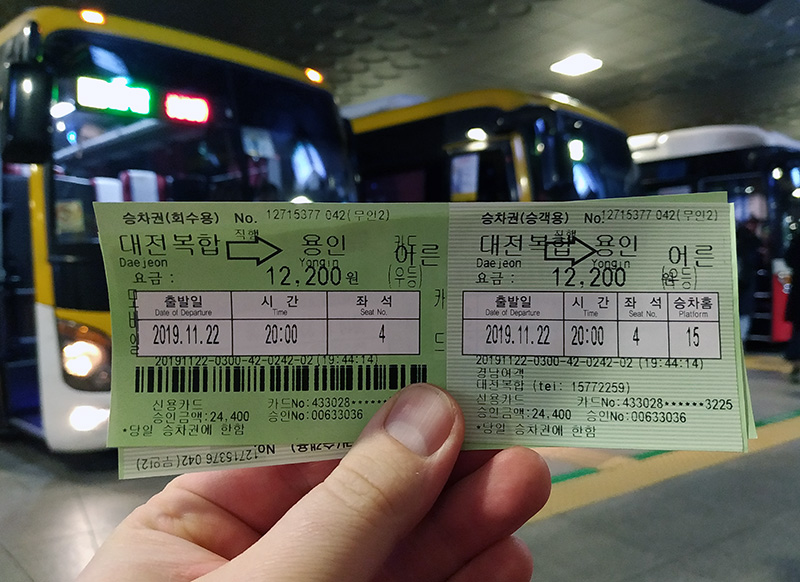
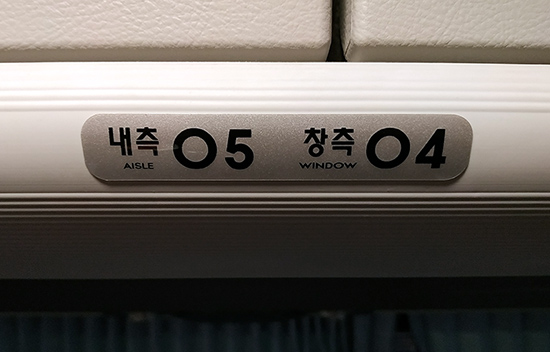
If you are bringing items with you that you don’t want on your lap, you can store them above you but the space there is very limited. If you have larger items you should consider putting them under the bus. Most drivers don’t want the passengers to open or close this storage area and will probably interject if you start to open one by yourself.
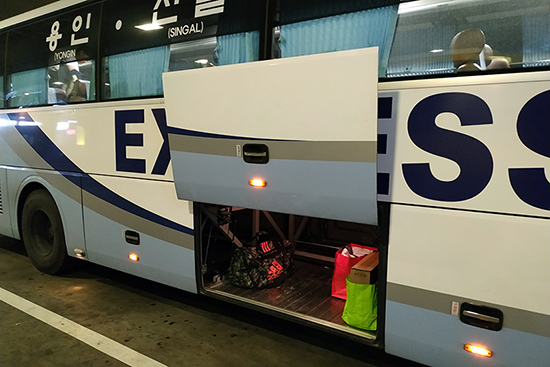
The space under these buses is also utilized for a unique kind of fast delivery service. When people need to get something in a few hours from another city, they’ll sometimes ship it from one bus terminal to another. Packages usually have the name and phone number of the recipient written in marker but have been removed from the image for privacy reasons. The recipient will need to go to the terminal and show them a receipt in order to receive their package. The same service is available with passenger trains.
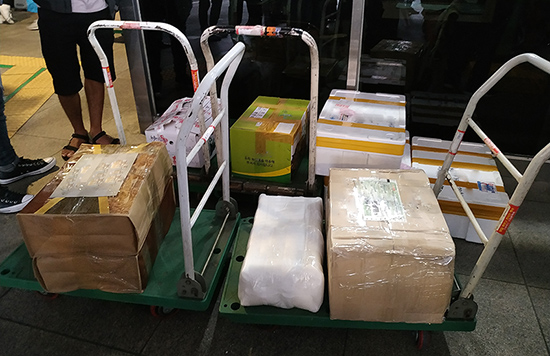
In Korea there are three classes of buses for intercity and express buses. When purchasing them from an app, you might get to narrow your search to the type of bus you wish to ride. The image below is copyright T Money and is from their intercity bus app [공식]시외버스 티머니 (Google Play, App Store).

Here are screenshots edited together from all three types of buses. On the left is a "general" bus, the middle is an "excellent" bus, and the bus on the right is a "premium" bus. Please note that these images make it appear the buses are different lengths. This is not the case, simply the mockup of each bus uses the same size image of seats when in reality “excellent” seats are bigger than “general” and “premium” seats are the biggest. If you want to see the combined image more clearly, click the picture to see a larger version. Images were screen captured and sewn together from the T Money intercity bus app, copyright T Money.
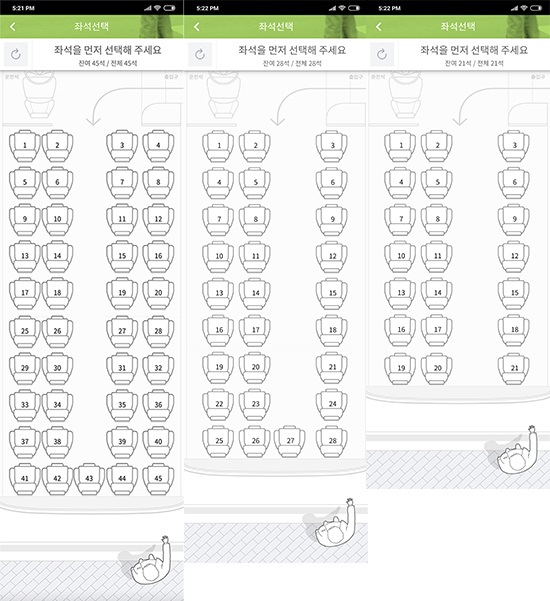
The lowest bus class is 일반 (一般, ilban) and translates into “general” or “common”. These are the cheapest buses to ride and also the buses that offer the most number of seats at 45 as they fit four passengers per row with five in the last row and have a total of 11 rows. The last row is physically higher than the other rows. Pictures of this bus class will be added in the future.
Here is an image of a ticket for a general bus. In this case it was issued by the transport card company Cash Bee. There will be some variation with designs but this and the image shown above are good representative examples. If you want to see the ticket image and its words more clearly, click the picture to see a larger version.
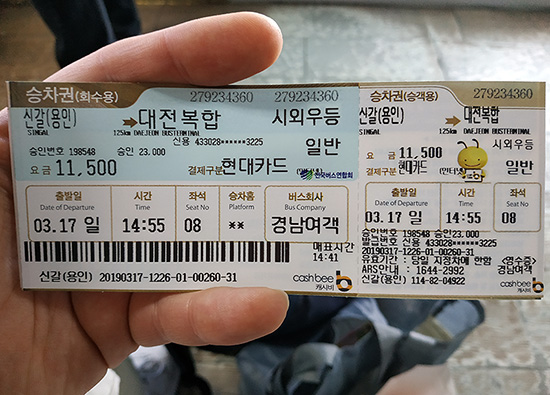
The next type of bus is 우등 (優等, udeung) which can translate into “excellent” or “superior” as it gives a better experience of the general buses. As the seats are larger, the number of seats per row is three with four in the last row and have a total of nine rows. The last row is physically higher than the other rows. As less passengers can ride these, and as these buses are more expensive to make than the general buses, the ticket price is higher. Comparisons of ticket prices is at the bottom of this page.
If you look at the ticket shown on the top of the page you can see (우등) above the seat number and a little to the right. This bus is also marked with 우등 by its entrance.
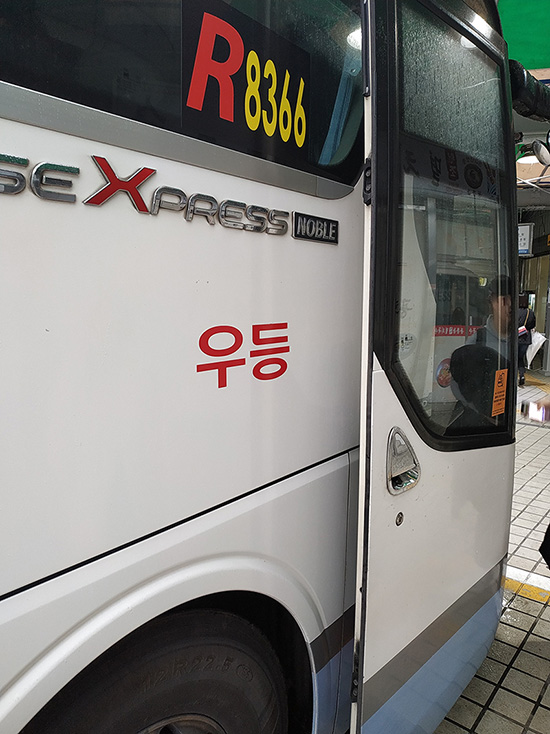
Here is a typical seat for an excellent bus. The padding is drastically improved, the back of the seat reclines and the leg rest can go up and down. There is a white cloth on the headrest for sanitation reasons. These are very common in itnercity and express buses and also trains. Occasionally the front and/or rear side of these will be used as an advertising space.
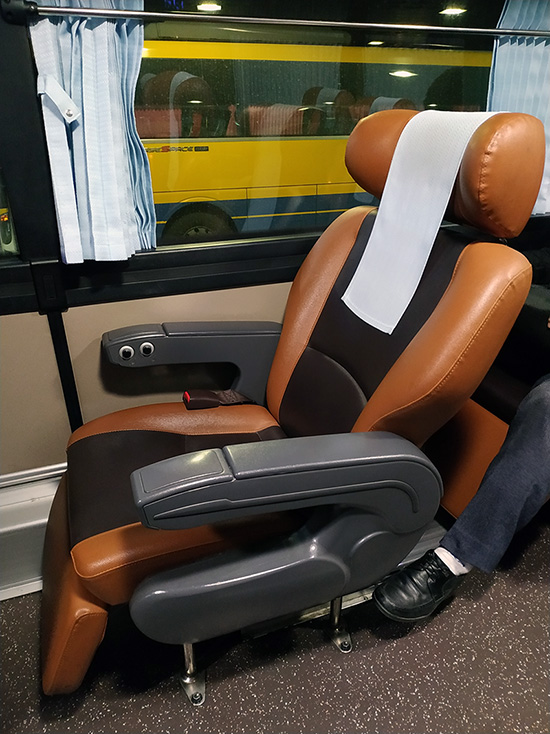
Here is a shot of inside the bus looking from the front toward the back. Curtains can open and close but there are gaps at times preventing a perfect block out of the sun.
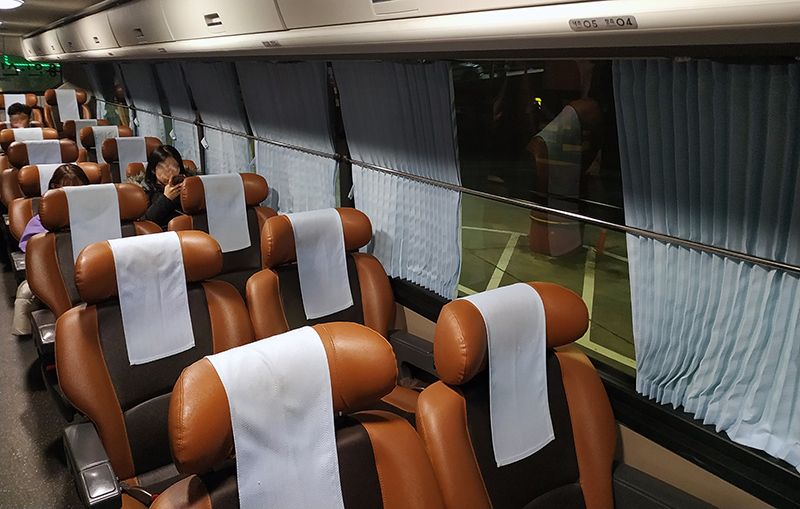
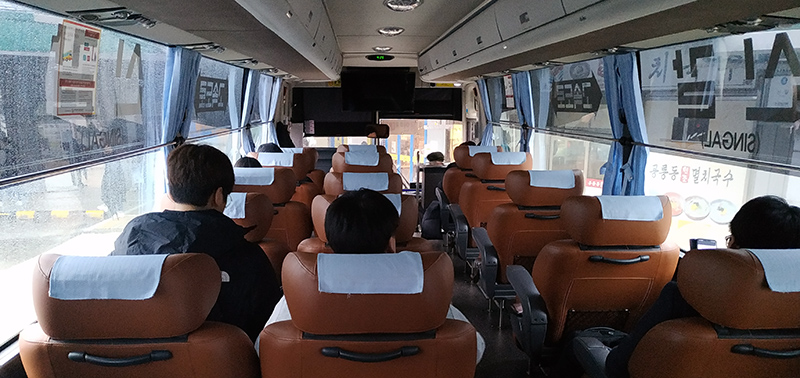
Looking above the seats we can see the seat numbers and some storage but this is very limited. Handbags can fit but backpacks with a few textbooks might be too much.
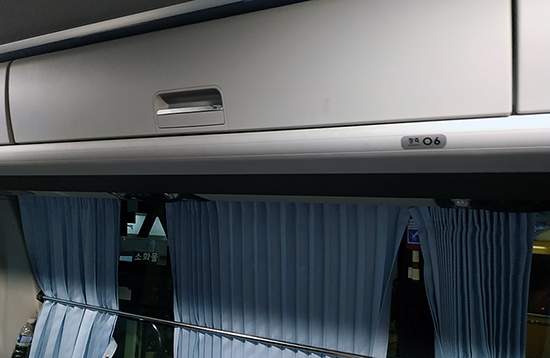
The curtains do block some light but are not thick. If you are sensitive to bright sunlight you should consider bringing sunglasses. Note the backwards 전 from 대전 (Daejeon City) that is viewable through the curtain. Also noteworthy are the emergency hammers to break the windows in case of an emergency.
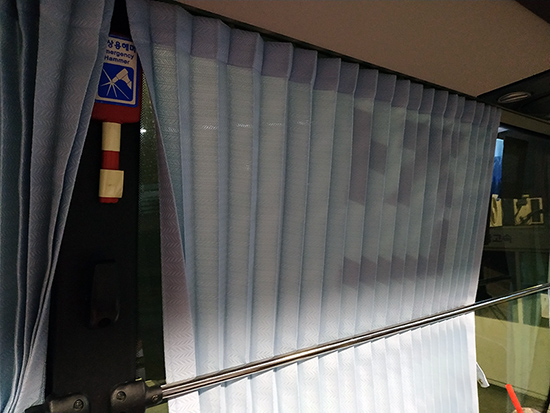
It is difficult to see in these images, but there are coat hooks installed on the pillars between the windows.
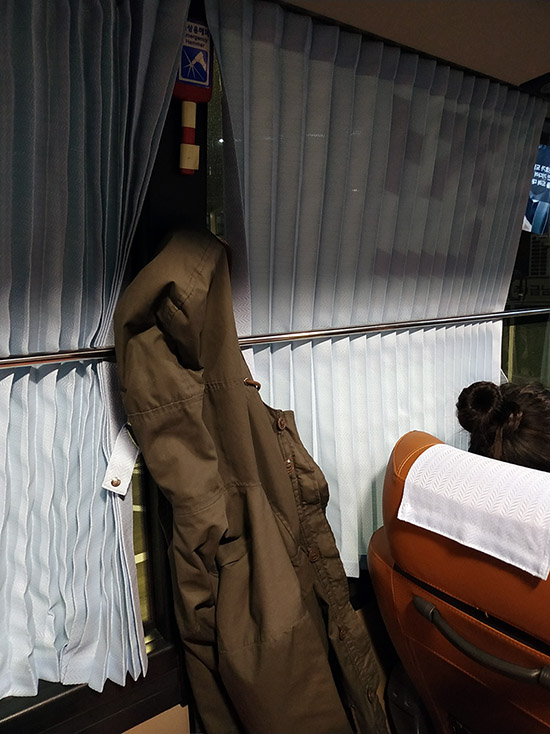
Each seat has its own light and air conditioning vent. Drivers frequently don’t turn on the air conditioning unless they are hot or passengers ask them to turn it on. If you are hot, talk to the driver so you can get some cool air.
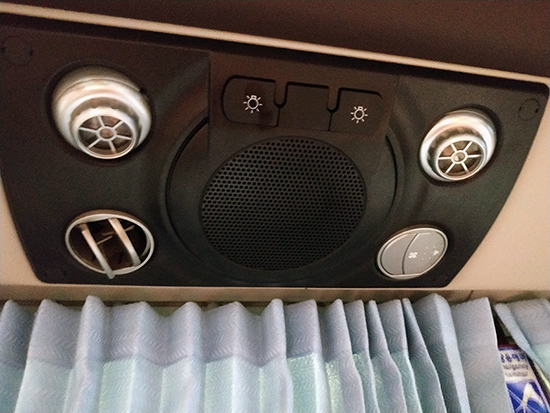
If you are traveling with a friend and are seating together, you might want to move the armrest out of the way. First buckle your seatbelts as this process will hide them once the armrest is out of the way. Pull the armrest toward the back of the chairs, then push it all the way down until the armrest lays flat.

The last and comparably newest type of bus is 프리미엄 (“premium” used as a phonetic loanword). This bus class was announced as Premium Gold Express in mid-2016 and started November of that year initially with express routes before expanding to intercity routes. Much like the “excellent” class of buses, premium buses have three seats per row, but differs as the last row also has only three seats. The buses do not appear to be shorter in length but only have seven rows as the seating takes up more space and also offer an improved reclining angle of 165° excellent buses recline at 139°. The number of amenities, including individual privacy curtain, personal light, USB charging, and entertainment screens also make these seats larger. The image below was released as a promotional image by the Ministry of Land, Infrastructure and Transport.
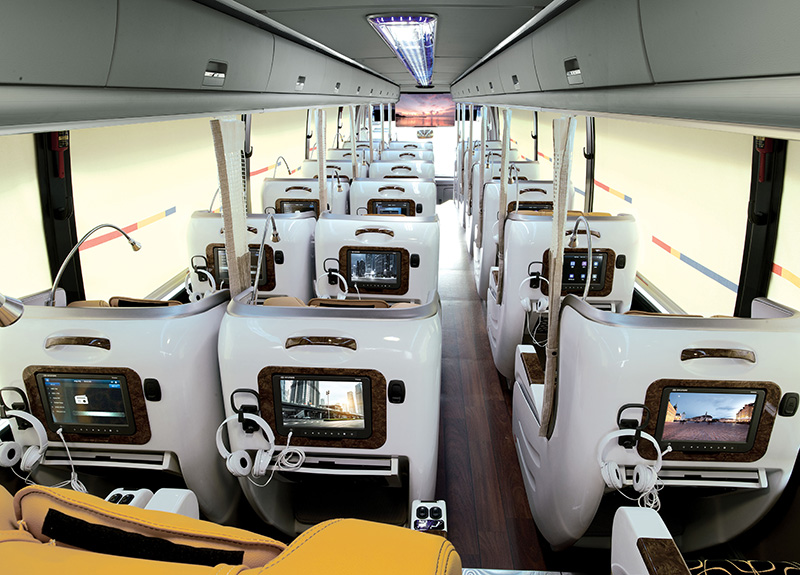
The seats are noticeably taller for additional privacy. Note how much higher the seat goes beyond the headrest.
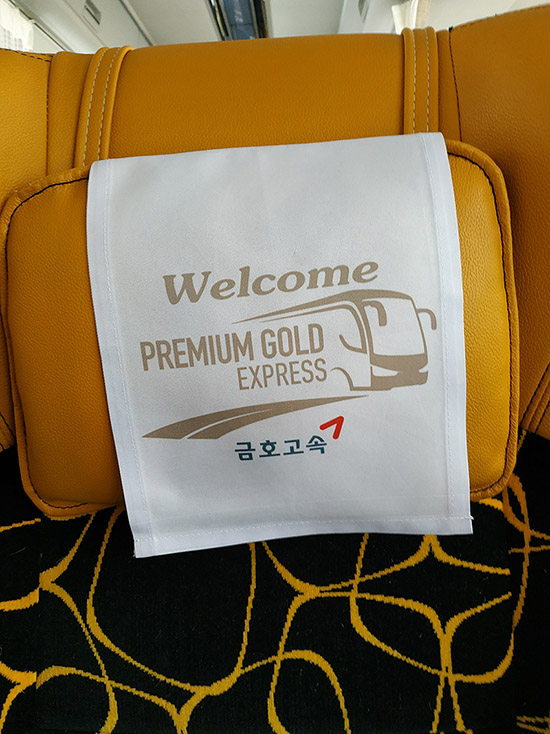

Each seat has its own curtain, including the two seats that are side by side. In this instance one of them has drawn the curtain. If you are curious the orange and aqua blue images on the TV at the front of the vehicle, the color pattern indicates what seats have not been sold (white), which seats have been sold but the person has not scanned their ticket yet (aqua blue), and which seats have their passenger checked in (orange). This is common on excellent buses as well.

The individuals seats to the right also have their own curtain separating them and everyone to the left. The window curtain has been replaced by a window screen so you no longer have to worry about sunlight sneaking around the edge of a window curtain.
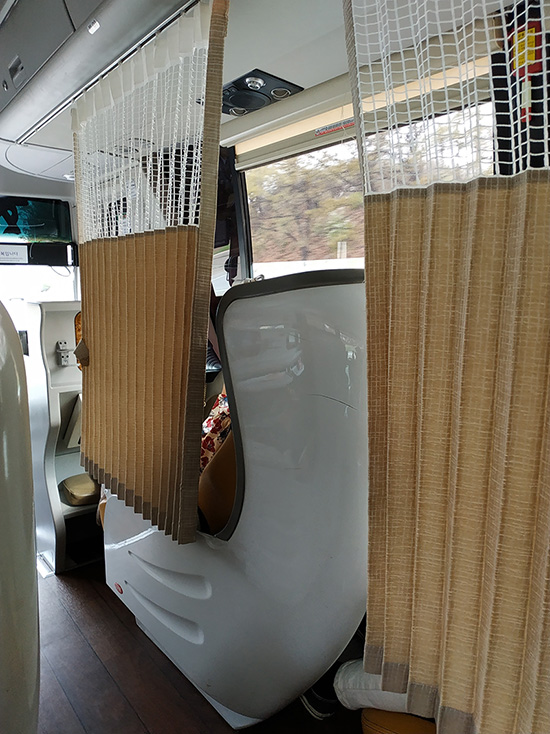
Seats recline within their large plastic shell, so you don’t need to be concerned about taking up the personal space of the passenger behind you. There is a small added space for putting your feet up within the shell in front of you.
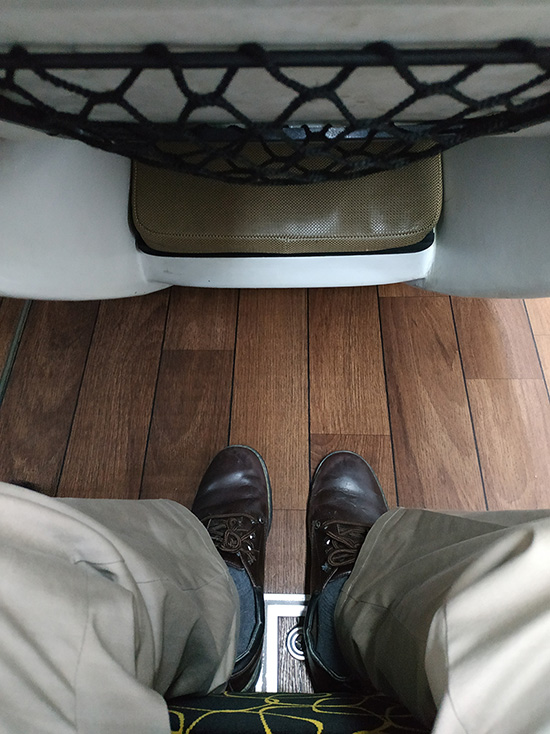
The controls to adjust your seatback and leg rest look like this. Here are several USB charging ports as well. Do not expect the bus to have your cable, as it will not be on the bus. If you want to charge your phone, make sure to bring the cable.
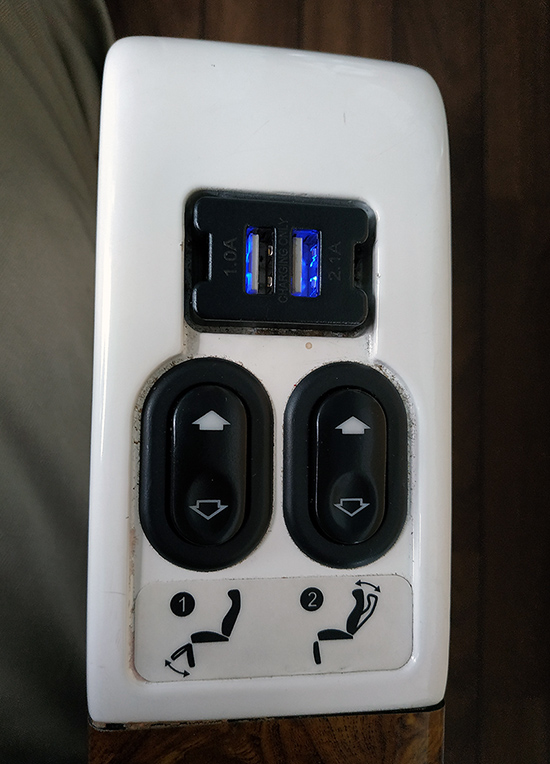
The entertainment console is now individualized as opposed to only having a single large TV at the front of the bus. The menu is bilingual with Korean and English. It is unclear how much media contents are common for these premium buses.
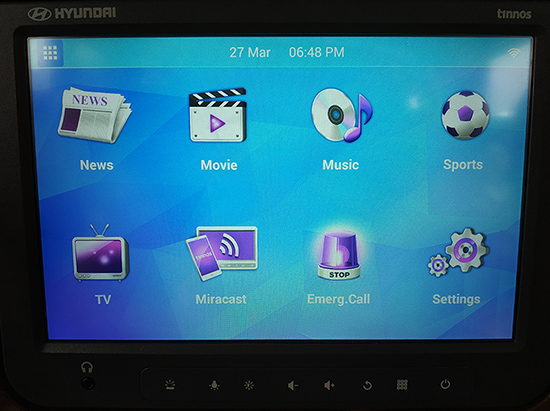
Here are the buttons and headphone jack that is under the TV.

If you press the button labeled Emerg.Call you have two options; the need for the vehicle to stop so you can use the restroom and an intercom connecting you with the driver but do not expect the driver to speak English.

For comparison reasons, we compared the prices of these three types of intercity buses going from Nambu Terminal (남부터미널) in Seoul to Gohyeon Terminal (고현터미널) in Geoje City near Busan. Going from northwest to southeast, this is one of the longest bus rides and takes 4 1/2 hours meaning this is basically the highest bus prices you’ll see. Going that route at the time of this writing, the general bus costs 24,800 KRW, excellent bus 36,900 KRW, and the premium bus 44,800 KRW.
For a more realistic difference let’s compare trips between Express Bus Terminal (서울고속터미널) in Seoul and Bokhab Terminal (복합터미널) in Daejeon, which takes roughly 2 hours. General buses charge 10,300 KRW, excellent buses 15,100 KRW, premium buses 19,600 KRW, and Simya premium buses 21,500 KRW.